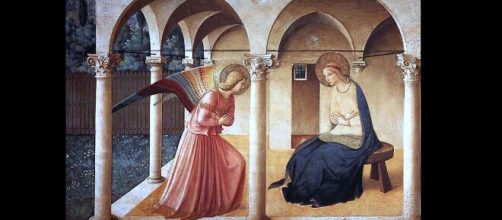How do you get people to put down their cell phones – not at the dinner table or in restaurants, but in the street? How do you impel pedestrians to look up from texting?
Based on a Hyperallergic Magazine report unrelated to cell phones, the Prado Museum provides the unintended answer. Spain’s national art museum has flung open the doors and let some of its illustrious art out into the streets of Madrid.
Outdoor museum
Throughout the capital city, more than two dozen framed, full-scale replicas of the museum’s art greats – like Rembrandt, Raphael, Velasquez, El Greco, and Goya – hang on fences and faces of schools, libraries, parks, and food markets.
As the Prado website puts it, great art is “just around the corner,” a reference to the city’s return to normalcy after the pandemic.
Looking up
Clearly, the Prado wasn’t thinking about breaking people’s cell phone habit so much as getting them into the art-looking habit. Owing to more than a year of being closed, the museum wants people to get back the habit of paying attention to the master art owned by Spain.
Seeing paintings in the street can pack a mighty wallop on casual passersby. I’m thinking of Fra Angelico’s "The Annunciation" hanging on the outside gate of the Royal Botanical Garden of Madrid. He painted a lot of these, but this one is particularly distinctive.
Before I get into the distinction, it’s key to point out that was a painter in the Renaissance – a time for bringing back the humanist values of old Rome and Greece, when even the gods were rendered in the image of man.
Focus on the human condition had blurred in the Middle Ages, that stretch between the ancient world and the Renaissance. For a thousand years, all eyes turned from the secular to the celestial. And Renaissance artists like Fra Angelico reset the relays.
Renaissance reality
Rather than heavenly harmony, the earthly variety became the lesson of the day. Renaissance artists studied ways to transform two-dimensional planes into three-dimensional panoramas using perspective. They also paid attention to the way people looked and felt. Unlike their predecessors, they portrayed people as distinct, one from the other.
Now back to Fra Angelico's "The Annunciation" at the Prado. Besides Virgin Mary getting the word that she is pregnant; you see in the background on the far left side Adam and Eve being expelled from the Garden of Eden.
As if to make sure you don’t miss that action, Fra Angelico painted a diagonal ray of light straight from Mary to the pair.
Cautionary tale
The small, background detail of Adam and Eve, not easily noticeable, has me wondering if pedestrians seeing this painting up close in the street, rather than at the prescribed distance in a museum setting, will spot the couple. And will seeing that remind them that indulging in forbidden fruit has consequences? Wouldn’t that be something – witnessing a morality play in the middle of a street?


